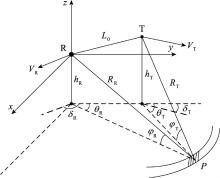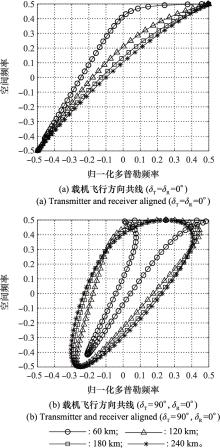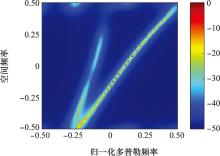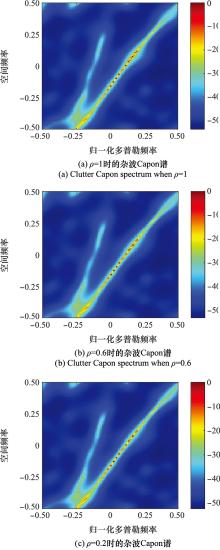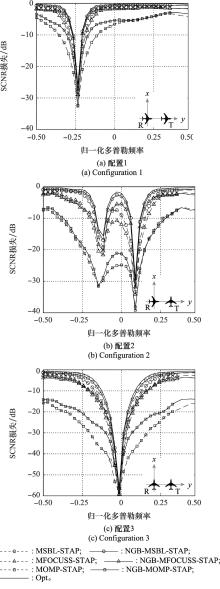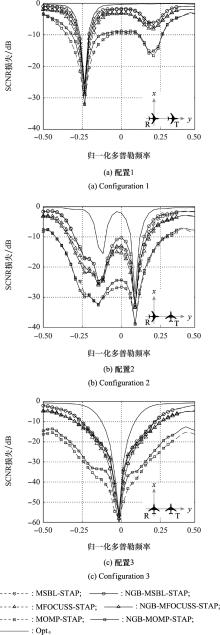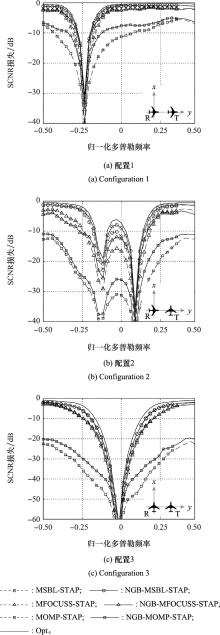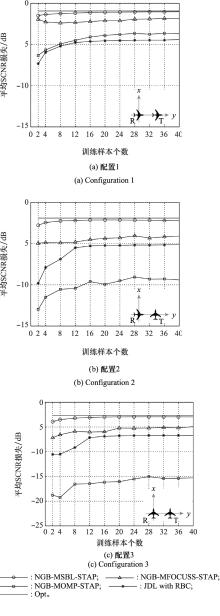Systems Engineering and Electronics ›› 2024, Vol. 46 ›› Issue (2): 517-525.doi: 10.12305/j.issn.1001-506X.2024.02.16
• Sensors and Signal Processing • Previous Articles
Bistatic airborne radar clutter suppression method based on sparse recovery
An'an WANG, Wenchong XIE, Yongliang WANG
- Radar weapon Application Engineering Key Research Laboratory, Air Force Early Warning Academy, Wuhan 430019, China
-
Received:2022-08-12Online:2024-01-25Published:2024-02-06 -
Contact:Wenchong XIE
CLC Number:
Cite this article
An'an WANG, Wenchong XIE, Yongliang WANG. Bistatic airborne radar clutter suppression method based on sparse recovery[J]. Systems Engineering and Electronics, 2024, 46(2): 517-525.
share this article
| 1 | WARD J. Space-time adaptive processing for airborne radar[R]. MIT Lincoln Laboratory, 1994. |
| 2 | 王永良, 彭应宁. 空时自适应信号处理[M]. 北京: 清华大学出版社, 2000. |
| WANG Y L , PENG Y N . Space-time adaptive processing[M]. Beijing: Tsinghua University Press, 2000. | |
| 3 | FALLAH A, BAKHSHI H. Extension of adaptive angle-Doppler compensation (AADC) in STAP to increase homogeneity of data in airborne bistatic radar[C]//Proc. of the 6th International Symposium on Telecommunications (IST), 2012: 367-372. |
| 4 | LAPIERRE F D , VERLY J G . Registration-based range-dependence compensation in bistatic STAP radars[J]. EURASIP Journal on Advances in Signal Processing, 2005, 2005 (1): 85- 98. |
| 5 |
VARADARAJAN V , KROLIK J L . Joint space-time interpolation for distorted linear and bistatic array geometries[J]. IEEE Trans.on Signal Processing, 2006, 54 (3): 848- 860.
doi: 10.1109/TSP.2005.862941 |
| 6 | 阳召成. 基于稀疏性的空时自适应处理理论和方法[D]. 长沙: 国防科学技术大学, 2013. |
| YANG Z C. Theory and methods of sparsity-based space-time adaptive processing[D]. Changsha: National University of Defense Technology, 2013. | |
| 7 |
COTTER S F , RAO B D , ENGAN K , et al. Sparse solutions to linear inverse problems with multiple measurement vectors[J]. IEEE Trans.on Signal Processing, 2005, 53 (7): 2477- 2488.
doi: 10.1109/TSP.2005.849172 |
| 8 | 孙珂, 张颢, 李刚, 等. 基于杂波谱稀疏恢复的空时自适应处理[J]. 电子学报, 2011, 39 (6): 1389. |
| SUN K , ZHANG H , LI G , et al. STAP via sparse recovery of clutter spectrum[J]. Acta Electronica Sinica, 2011, 39 (6): 1389. | |
| 9 | 段克清, 袁华东, 许红, 等. 稀疏恢复空时自适应处理技术研究综述[J]. 电子学报, 2019, 47 (3): 748- 756. |
| DUAN K Q , YUAN H D , XU H , et al. An overview on sparse recovery space-time adaptive processing technique[J]. Acta Electronica Sinica, 2019, 47 (3): 748- 756. | |
| 10 | 吕晓德, 杨璟茂, 岳琦, 等. 基于稀疏贝叶斯学习的机载双基雷达杂波抑制[J]. 电子与信息学报, 2018, 40 (11): 2651- 2658. |
| LYU X D , YANG J M , YUE Q , et al. Airborne bistatic radar clutter suppression based on sparse bayesian learning[J]. Journal of Electronics and Information Technology, 2018, 40 (11): 2651- 2658. | |
| 11 |
HE P , HE S , YANG Z , et al. An off-grid STAP algorithm based on local mesh splitting with bistatic radar system[J]. IEEE Trans.on Signal Processing Letters, 2020, 27, 1355- 1359.
doi: 10.1109/LSP.2020.3010161 |
| 12 | 李志汇, 张永顺, 高乾, 等. 基于局部搜索OMP的网格失配STAP算法[J]. 系统工程与电子技术, 2018, 40 (6): 1221- 1226. |
| LI Z H , ZHANG Y S , GAO Q , et al. Off-grid STAP algorithm based on local search orthogonal matching pursuit[J]. Systems Engineering and Electronics, 2018, 40 (6): 1221- 1226. | |
| 13 |
FENG W , GUO Y , ZHANG Y , et al. Airborne radar space time adaptive processing based on atomic norm minimization[J]. Signal Processing, 2018, 148, 31- 40.
doi: 10.1016/j.sigpro.2018.02.008 |
| 14 |
BAI G T , TAO R , ZHAO J , et al. Parameter-searched OMP method for eliminating basis mismatch in space-time spectrum estimation[J]. Signal Processing, 2017, 138, 11- 15.
doi: 10.1016/j.sigpro.2017.03.003 |
| 15 |
DUAN K Q , LIU W J , DUAN G Q , et al. Off-grid effects mitigation exploiting knowledge of the clutter ridge for sparse recovery STAP[J]. IET Radar, Sonar and Navigation, 2018, 12 (5): 557- 564.
doi: 10.1049/iet-rsn.2017.0425 |
| 16 | 吴洪, 王永良. 双基地机载预警雷达杂波建模与分析[J]. 电子学报, 2006, 34 (12): 2209. |
| WU H , WANG Y L . Modeling and analysis of the ground clutter spectrum on bistatic airborne early warning radar[J]. Acta Electronica Sinica, 2006, 34 (12): 2209. | |
| 17 | 王泽涛. 基于稀疏表示的机载雷达STAP技术研究[D]. 长沙: 国防科学技术大学, 2016. |
| WANG Z T. STAP technique for airborne radar based on sparse representation[D]. Changsha: National University of Defense Technology, 2016. | |
| 18 |
DUAN K Q , WANG Z T , XIE W C , et al. Sparsity-based STAP algorithm with multiple measurement vectors via sparse Bayesian learning strategy for airborne radar[J]. IET Signal Processing, 2017, 11 (5): 544- 553.
doi: 10.1049/iet-spr.2016.0183 |
| 19 | 文才, 王彤, 吴建新. 直接数据域迭代空时自适应处理方法[J]. 系统工程与电子技术, 2014, 36 (5): 831- 837. |
| WEN C , WANG T , WU J X . Direct data domain approach with iterative space-time adaptive processing[J]. Systems Engineering and Electronics, 2014, 36 (5): 831- 837. | |
| 20 | JAFFER A G, HIMED B, HO P T. Estimation of range-dependent clutter covariance by configuration system parameter estimation[C]//Proc. of the IEEE International Radar Conference, 2005: 596-601. |
| 21 | 张柏华, 谢文冲, 王永良, 等. 基于最大似然估计的机载双基地雷达杂波抑制方法[J]. 系统工程与电子技术, 2010, 32 (8): 1591- 1595. |
| ZHANG B H , XIE W C , WANG Y L , et al. Airborne bistatic radar clutter suppression method based on maximum likelihood estimation[J]. Systems Engineering and Electronics, 2010, 32 (8): 1591- 1595. | |
| 22 |
CHEN J , HUO X . Theoretical results on sparse representations of multiple-measurement vectors[J]. IEEE Trans.on Signal Processing, 2006, 54 (12): 4634- 4643.
doi: 10.1109/TSP.2006.881263 |
| 23 | 段克清, 王泽涛, 谢文冲, 等. 一种基于联合稀疏恢复的空时自适应处理方法[J]. 雷达学报, 2014, 3 (2): 229- 234. |
| DUAN K Q , WANG Z T , XIE W C , et al. A space-time adaptive processing algorithm based on joint sparse recovery[J]. Journal of Radars, 2014, 3 (2): 229- 234. |
| [1] | Ran LAI, Gang SUN, Wei ZHANG, Tao ZHANG. Space-time moving target parameter estimation algorithm based on non-convex relaxation of atomic norm [J]. Systems Engineering and Electronics, 2023, 45(9): 2761-2767. |
| [2] | Yali NIU, Jingwei XU, Guisheng LIAO, Qingyun KAN, Guangjun LIU. Clutter suppression approach for missile-borne HPRF radar with sum-difference antenna [J]. Systems Engineering and Electronics, 2023, 45(8): 2455-2462. |
| [3] | An'an WANG, Wenchong XIE, Wei CHEN, Yuanyi XIONG, Yongliang WANG. Clutter and main-lobe suppression jamming suppression method for bistatic airborne radar [J]. Systems Engineering and Electronics, 2023, 45(3): 699-707. |
| [4] | Junling ZHANG, Mei DONG, Baixiao CHEN. Sea clutter suppression algorithm based on tunable Q-factor wavelet transform [J]. Systems Engineering and Electronics, 2023, 45(2): 343-351. |
| [5] | Cheng CHEN, Xiaoji SONG, Zhihua HE, Tao LIU, Laibao CAO, Yi SU. GPR clutter suppression method by low rank and sparse decomposition [J]. Systems Engineering and Electronics, 2023, 45(10): 3058-3064. |
| [6] | Yuzhuo WANG, Shengqi ZHU, Ximin LI, Lan LAN. Range ambiguous clutter suppression for FDA MIMO bistatic radar with main lobe correction [J]. Systems Engineering and Electronics, 2022, 44(5): 1483-1494. |
| [7] | Wenjing LI, Zhuolin LI, Zhentao YUAN. Sea clutter suppression and target extraction algorithm based on sparse reconstruction [J]. Systems Engineering and Electronics, 2022, 44(3): 777-785. |
| [8] | Mingze WANG, Wei LI, Junwei MA, Xiangping LI. Clutter suppression algorithm based on pixel vector elimination in through-the-wall radar [J]. Systems Engineering and Electronics, 2022, 44(3): 827-833. |
| [9] | Tao CHEN, Lin SHI, Mengyu SHEN. Gridless DOA estimation algorithm based on M-FIPM [J]. Systems Engineering and Electronics, 2022, 44(2): 427-433. |
| [10] | Yanling SHI, Lei WANG, Junhao LI. CFAR detection for small targets on sea surface based on singular value decomposition in projection space [J]. Systems Engineering and Electronics, 2022, 44(2): 512-519. |
| [11] | Xiaojiao PANG, Yongbo ZHAO, Chenghu CAO, Yili HU, Sheng CHEN. Reduced-dimension space-time adaptive processing method based on the covariance fitting criterion [J]. Systems Engineering and Electronics, 2022, 44(1): 86-93. |
| [12] | Yuqi LIU, Xianrong WAN, Jianxin YI, Hengyu KE. Clutter suppression method for passive radar based on channel Doppler characteristic [J]. Systems Engineering and Electronics, 2021, 43(1): 55-61. |
| [13] | Mingming TIAN, Guisheng LIAO, Yunpeng LI, Shengqi ZHU. Clutter properties and suppression method of hypersonic platform radar [J]. Systems Engineering and Electronics, 2020, 42(2): 301-308. |
| [14] | Hao XIAO, Tong WANG, Cai WEN, Yuyu SU. Iteration-separable clutter suppression method for airborne planar array radar [J]. Systems Engineering and Electronics, 2020, 42(11): 2461-2470. |
| [15] | Ziwei DONG, Jun SUN, Jingming SUN, Meiyan PAN. Marine weak moving target detection based on sparse dictionary learning [J]. Systems Engineering and Electronics, 2020, 42(1): 30-36. |
| Viewed | ||||||
|
Full text |
|
|||||
|
Abstract |
|
|||||
